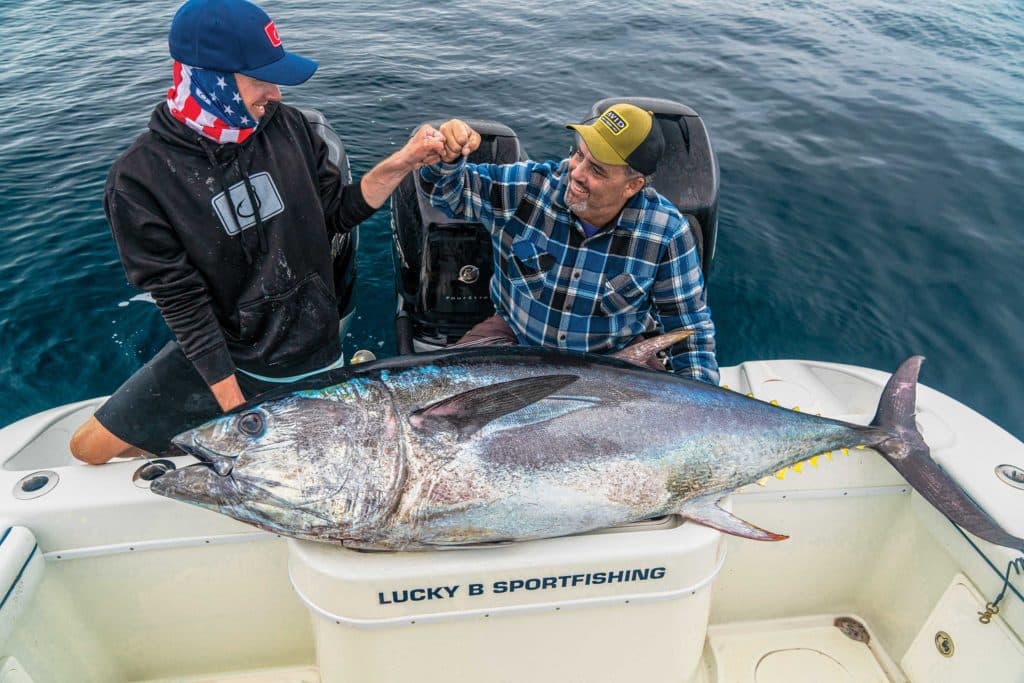
Wings splayed wide with a wooden skewer, a rigged flying fish glides across the surface like a zombie returning from the dead as captains Barry Brightenburg and Brandon Nelson sail it from a kite—buoyed by a helium-filled balloon—over Southern California’s fabled Cortes Bank.
Within two minutes, a hungry Pacific bluefin tuna rockets upward, exploding at the surface and inhaling the bait. “We’re bit!” Brightenburg yells while winding line quickly to get tight with the fish. With 130-pound-test braid and a 300-pound leader, Brightenburg applies maximum pressure and, within 20 minutes, battles the fish to a deep color. Five minutes later, Nelson sinks the first gaff. I sink the second, and together we hoist the plump 125-pound bluefin aboard.
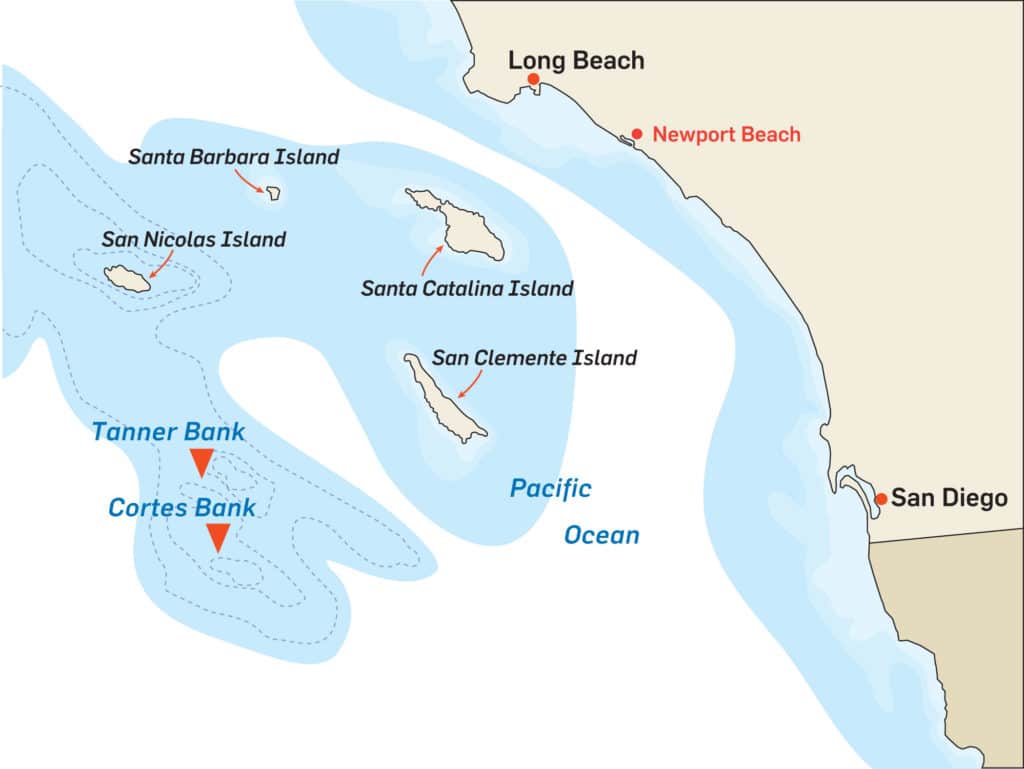
Bank Withdrawal
This was the first of four bluefins, capped off with a 250-pounder, brought aboard Lucky B, Nelson’s 36-foot center-console, on that day in October. Such stellar fishing points to the potential of Southern California’s most distant offshore bank—Cortes—as well as Tanner Bank. While bluefin tuna sometimes move closer to the coast, last season’s fishing around these banks proved epic at times, with many tuna over 200 pounds and some in excess of 300.
Rich ocean currents sweep the remote Pacific seamounts, generating nutrient- and plankton-laden upwellings that feed schools of anchovies, flying fish, mackerel, sardines and sauries. These, in turn, attract a host of gamefish, including bluefin tuna. During our trip, the fish finder confirmed the presence of tuna even before we started fishing, with schools marked clearly on the display at 100 feet.
Go the Distance
The distance, roughly 112 miles west of San Diego’s iconic Point Loma, increases the difficulty in getting here, but also decreases fishing pressure. “You have to pick good weather days and have the right boat to make the trip,” Brightenburg says. “Even on good days, you need to have the fuel capacity to make it out there and back safely.”
Traditionally, party boats and large sport-fishers have served as the vessels of choice for fishing Cortes and Tanner banks. But these days, fast, seaworthy center-console fishing machines, such as Nelson’s 36-footer, also fish the banks. “With triple Mercury 300 Verados, 477 gallons of fuel and speed over 50 mph on Lucky B, a 36-foot Yellowfin, I easily reach Cortes Bank and return to San Diego the same day,” Nelson says.
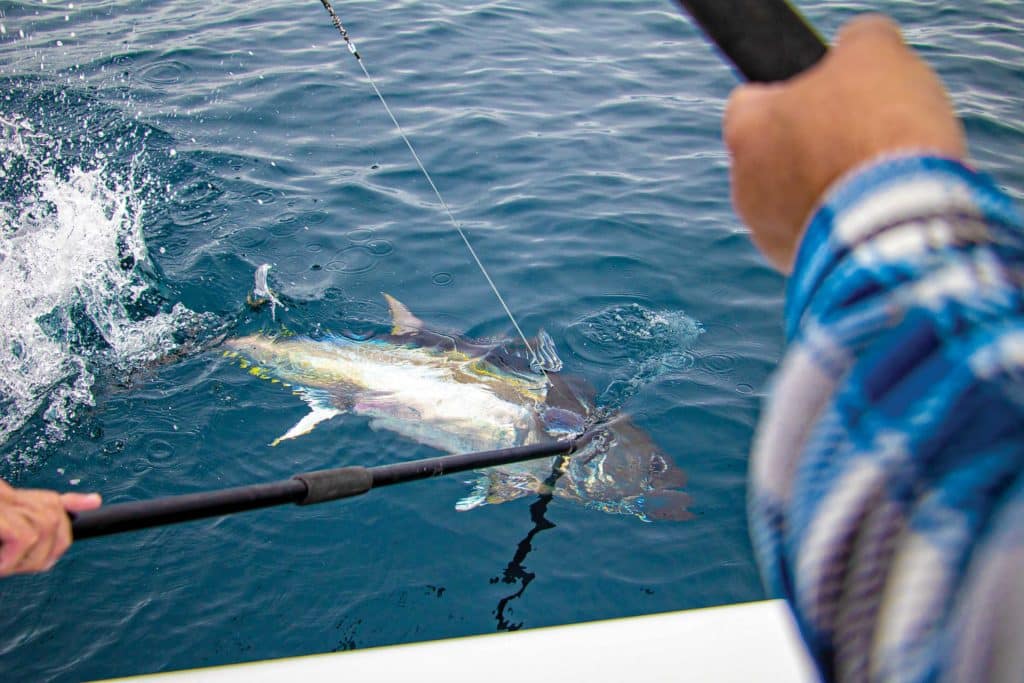
Preparation Matters
Research helps make the most of a tuna expedition. Brightenburg and Nelson diligently network with fellow anglers to find out if and where the bluefins are biting. This paid off big time on our trip. Though the action had been hot at Tanner Bank in the days leading up to our trip, new intel indicated the bluefin schools had shifted to Cortes.
Pacific bluefin tuna can become notoriously line-shy. Anglers who scale down their leaders might hook a fish, but a prolonged battle and the tuna’s sharp teeth usually lead to a high attrition rate on lighter lines, especially with fish over 100 pounds. That’s why kite-fishing for bluefins has skyrocketed in popularity off the California coast.
Dangling a bait from a kite line keeps the fishing line out of the water and unseen by the fish, enabling the use of heavier leaders that hold up during long fights. In addition, bluefins can grow wary of boats, and kites keep the baits at a distance.
Winging It
While live mackerel and rigged squid entice a bite, rigged flying fish prove most effective when kite-fishing for Pacific bluefins. For our trip, the skippers purchased about a dozen frozen flying fish from a tackle shop and put them on ice until rigging them with their wings spread to look as natural as possible.
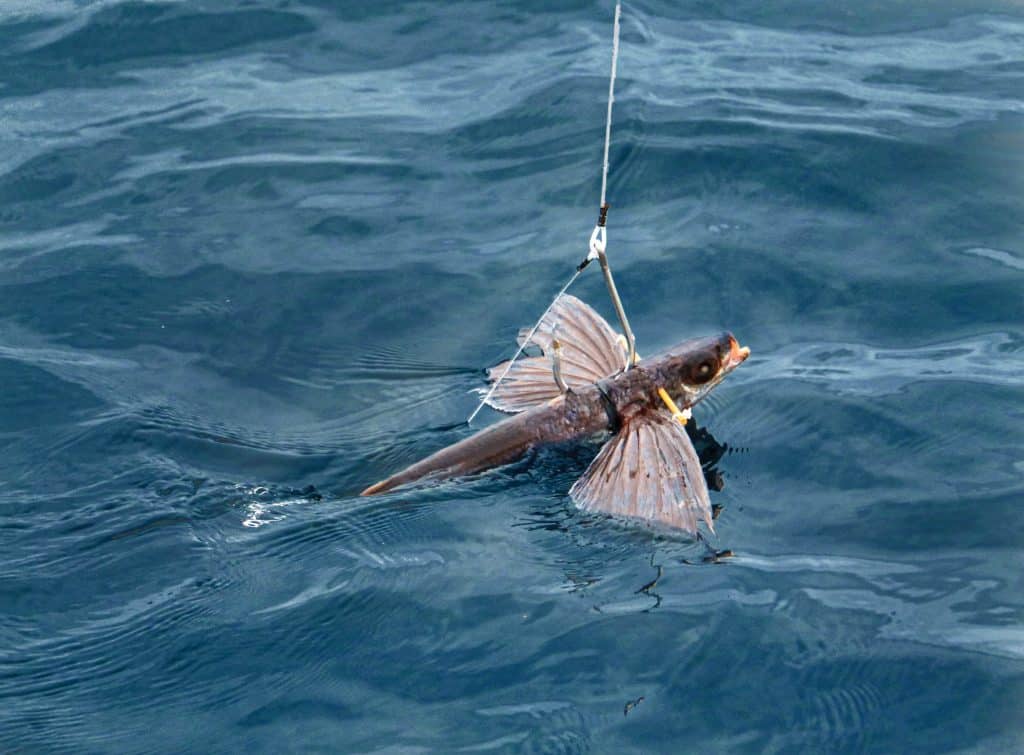
Kites from brands such as AFTCO and SFE work well for this style of fishing. However, a good weather day, while providing a comfortable and safe passage, has a downside—a lack of wind to fly a kite. Still days require a large balloon filled with helium to keep the kite aloft. Brightenburg secures the balloon with rigging floss behind it and tapes over the floss to keep it from slipping.
Flying Lessons
With an electric reel on a kite rod, the captains deploy the kite about 75 feet before attaching the fishing line with the rigged flying fish to the release clip. Then one skipper lets out the kite while the other free-spools the fishing reel to deploy the flyer about 100 yards from the boat.
This deployment technique works with a mild breeze, but in the absence of wind, it might be necessary to idle the boat ahead to put distance between the boat and bait. The same applies while actually fishing: A mild breeze will allow for drift-fishing, but slow-trolling might be in order to maintain the proper angle and separation between the boat and the kite.
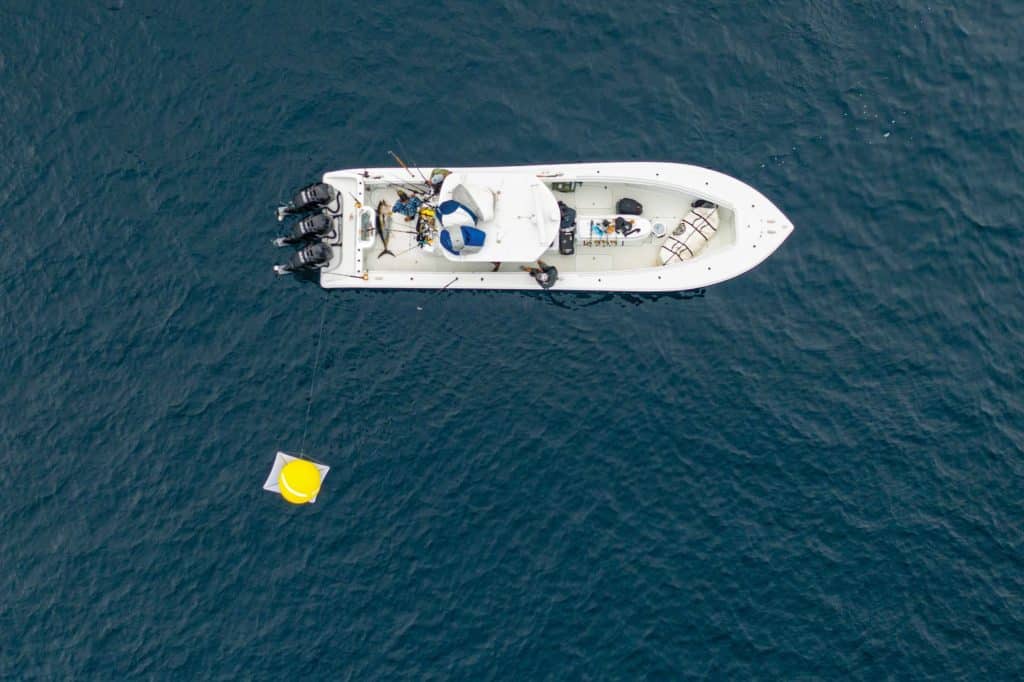
In either case, pay close attention to the bait to ensure it glides on or close to the surface. The idea is to replicate the behavior of a live flying fish. This requires attention and constant adjustment, reeling in or free-spooling to keep the bait in the strike zone. Keeping eyes on the bait also ensures that you see the strike and jump into action.
Heavyweights
Not all the fish on Cortes and Tanner banks are cows, the local nickname for tuna over 200 pounds. Many Pacific bluefins fall in the 50- to 80-pound range, but you never know when a big one will show up. Stout tackle is the order of the day. This means two-speed lever-drag reels such as an Okuma Makaira MK 50II, Penn International 50 VISX or Shimano Talica TAC50II spooled with 130-pound-test braid and a 25-foot-long, 300-pound-test -wind-on leader.
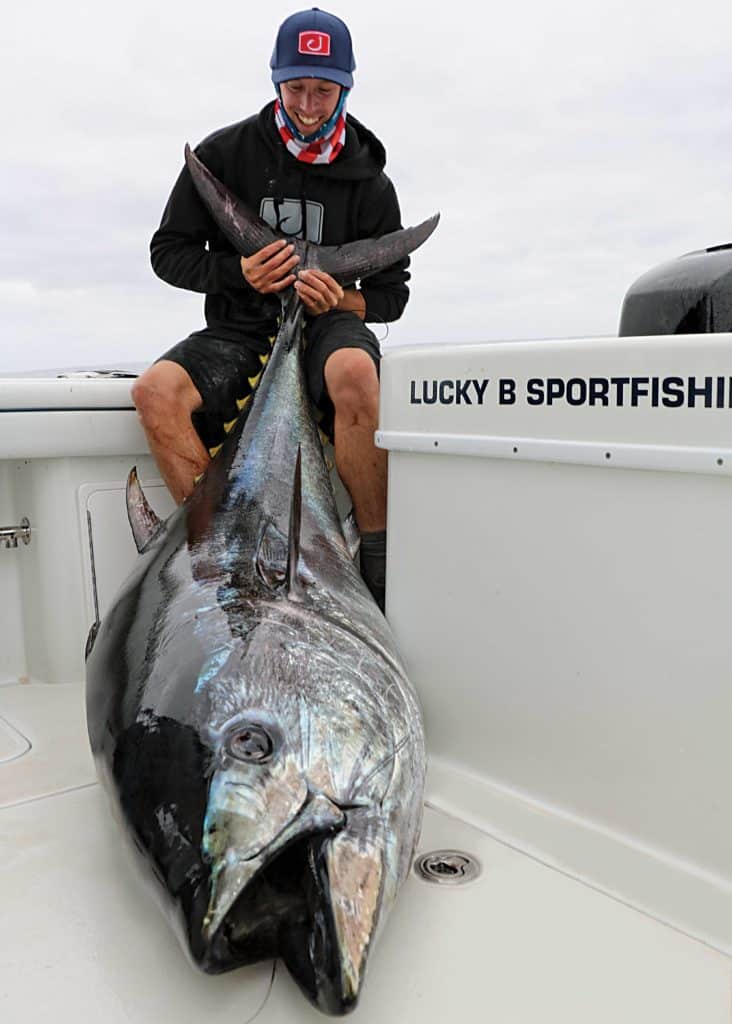
Most private-boat anglers use locally sourced, custom-built rods from Southern California brands such as Calstar and Seeker. Typically, these rods feature a short curved butt on a 5-foot blank rated for 80- to 130-pound line. The Winthrop Terminator Adjusta-Butt has become popular for its ability to quickly change from a curved to a straight butt at the press of a button.
Read Next: Side Tracker Spreader Bars for Bluefin Tuna
Once you hook a powerful Pacific bluefin tuna, you’ll be glad you came well-armed and ready to make an impressive withdrawal from Southern California’s bank of riches.
SWS Tackle Box
- Rods: Curved-butt 5-foot rod rated for 80- to 130-pound line
- Reels: Two-speed lever-drag reel such as Okuma Makaira MK 50II, Penn International 50 VISX or Shimano Talica TAC50II
- Line: 130-pound-test braid
- Terminal Rigs: 25-foot, 300-pound wind-on mono leader
SWS Planner
- What: Bluefin tuna from 50 to 300 pounds
- Where: Cortes and Tanner banks
- When: May to early November
Looking for a charter? Here are three choices:
Lucky B Sportfishing
Capt. Brandon Nelson
760-445-4834, luckybsportfishing.com
Pinnacle Sportfishing
Capt. Duane Mellor
619-850-7575, pinnaclesportfishing.com
Seasons Sportfishing
Capt. Jaime Thinnes
714-206-6146, seasonssportfishing.com









